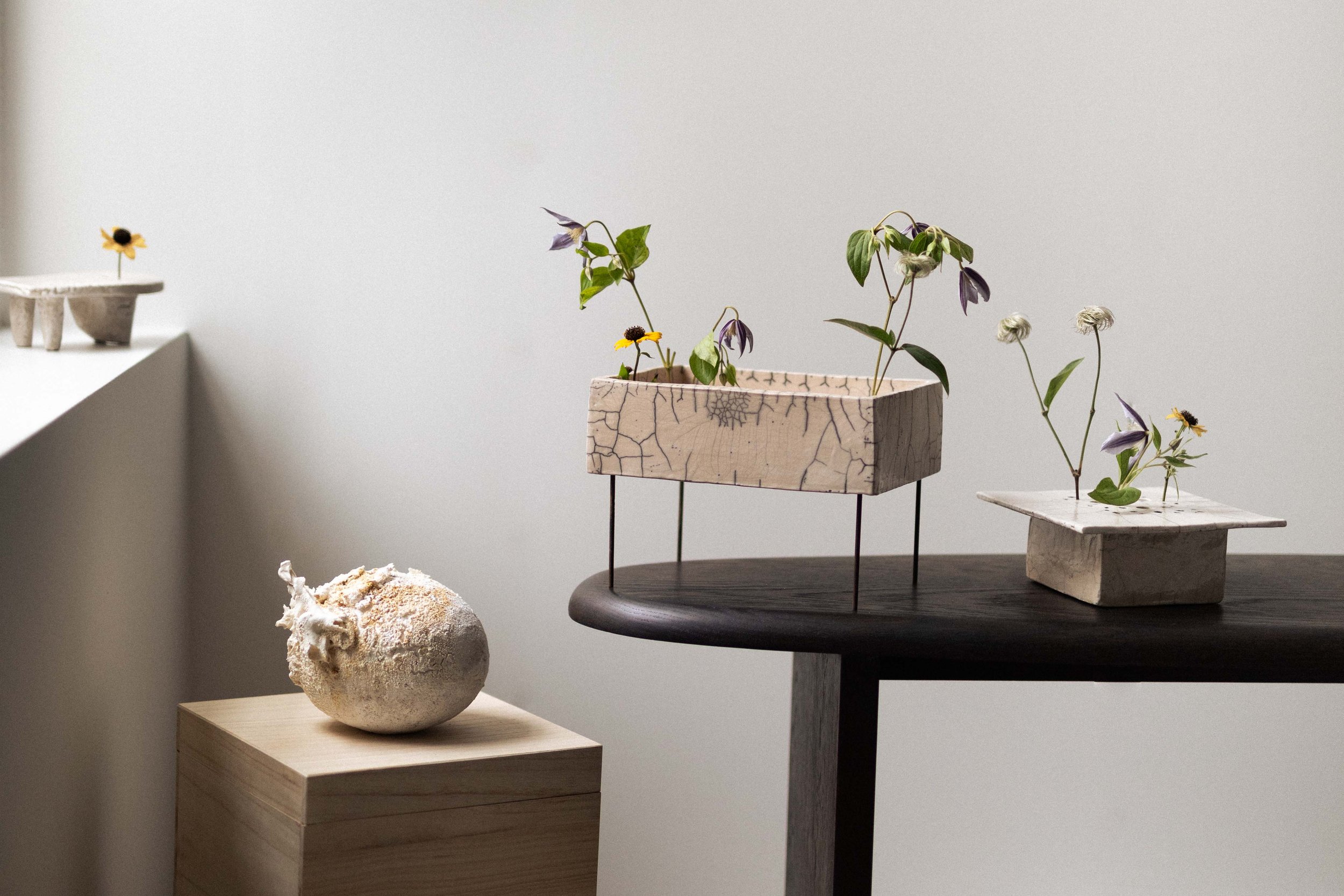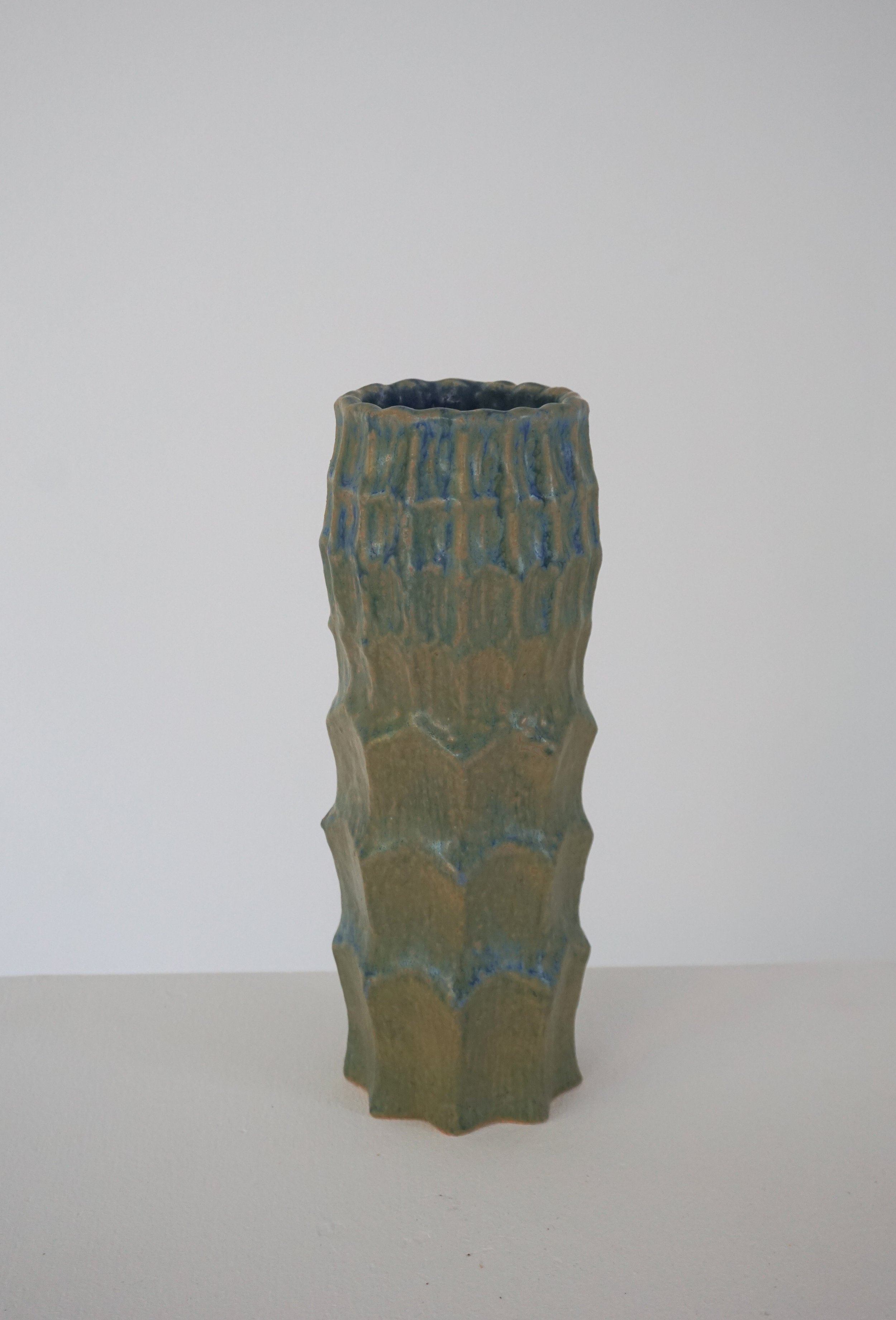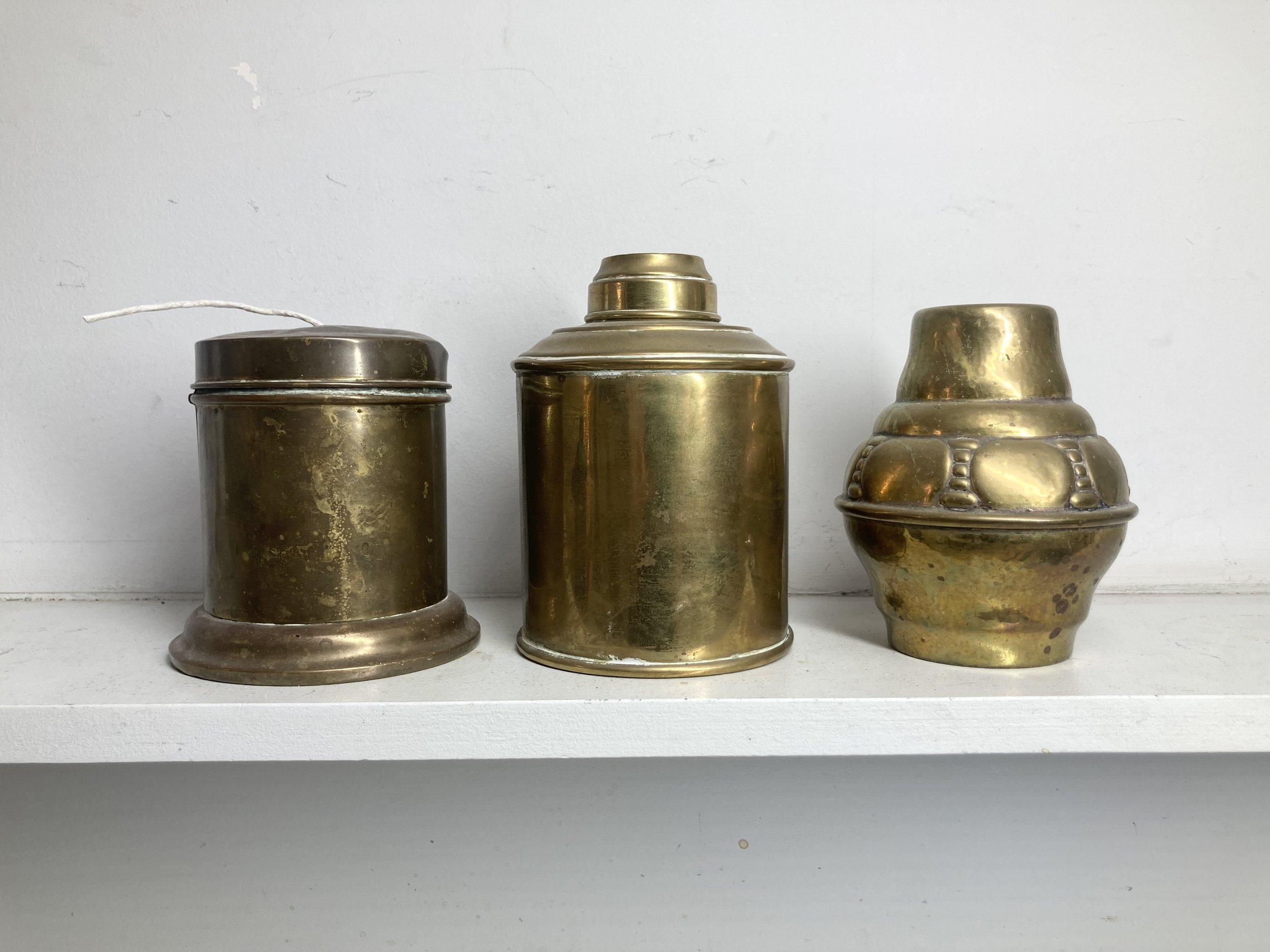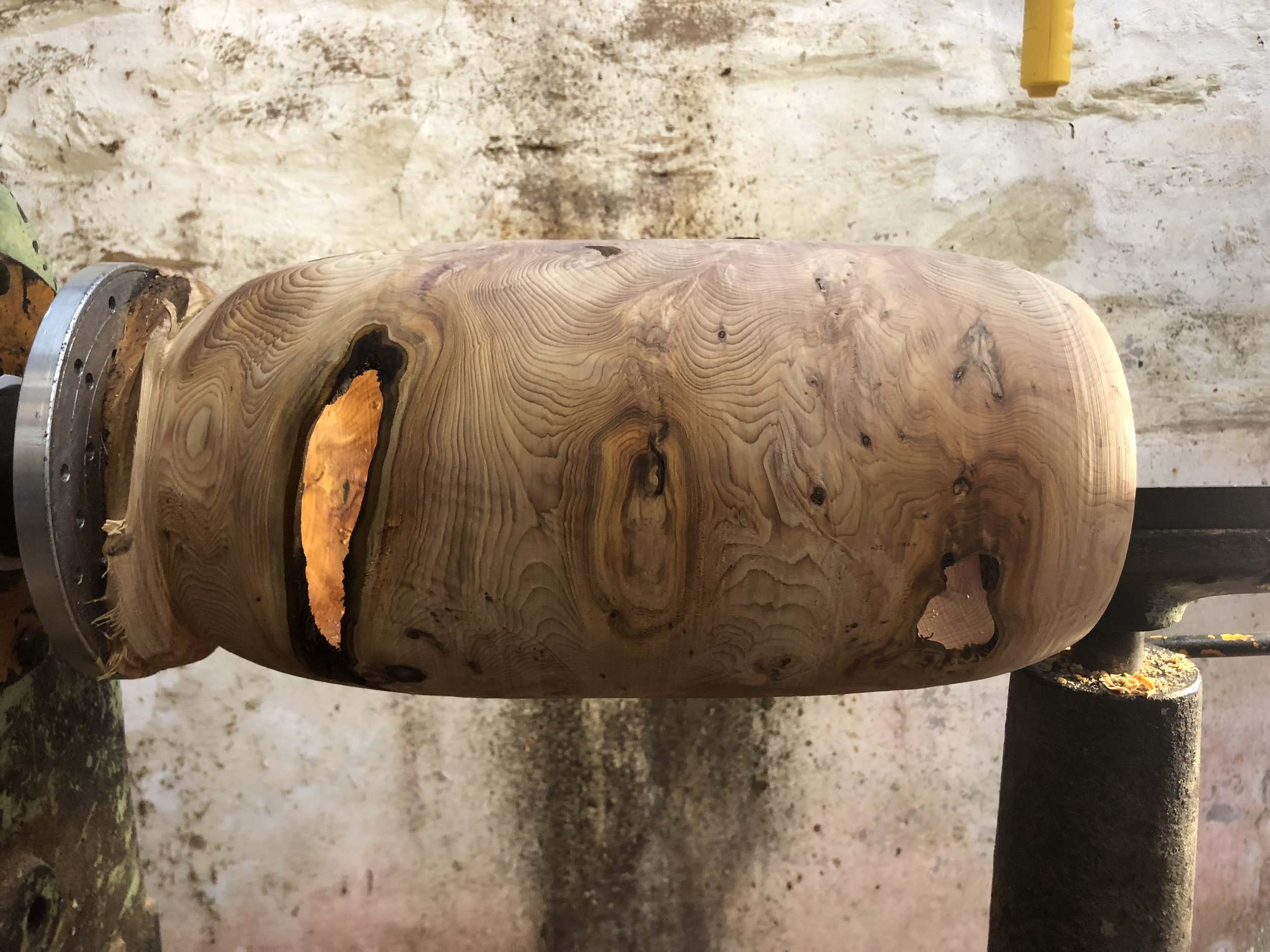
Making Memories
14th November - 15th January
The Makers on Memory
While creating their pieces for this special group show, the artists reflected on the theme of Memory. Each artist’s meditation presents their unique perspective: on their personal histories, the ephemeral nature of remembering, their material’s own ‘memory’ of process. Together, they reveal how intimately memory resonates through everyday life, taking form in the objects around us.
Eleanor Lakelin
Sandblasting sequoia shows how the soft summer growth erodes at a different rate to its harder winter counterpart. The ridged and recessed results mirror the wood’s growth between seasons: summer-fast, winter-slow. Both pieces are etched by time-grown and time-worn materiality. Cycles of organic growth and formal exploration here recall one of civilization’s oldest object forms, both used to contain and commemorate. Each vessel finds itself articulated in novel form, shaped unlike its predecessors in the studio, yet still spurred on by memory’s haptic suggestion.
Eleanor Lakelin - ‘Imprint #2’ and in studio
Aino Kajaniemi
Is it better to live in memories, in the future through dreams or in the present? There are many levels of memory. When I draw and weave, I am in the moment. I have such a deep awareness of weaving that I can forget the technique and concentrate on the essential: telling a story. Perhaps because of this experience, I have learned to live in the present and be present.
Memory is selective. In general, we remember happy moments more easily, but also sad things through our emotional experience. My tapestries depict the ephemeral nature of memories and their impact on our personality. How the crust of time fades emotions and colours.
Aino Kajaniemi - ‘Selective Memory’ and in studio
Celia Dowson
For Flow Gallery’s 25th anniversary I have been exploring Material Memory, how it can be captured in glass through its material fluidity. In the work molten glass flows into shape, contained within the boundaries of form through wave-like movements. Each piece in the collection reflects its making process; areas have been left exposed and raw, ‘droplets in glass’, or polished and refined to accentuate colour depth and material glow.
Each object is also a reflection of the non-visual memories we create over time; the object lives on, and the stories it holds will enrich. Within these thoughts I see material, process and object as providing a way for us to be more present and attentive to our everyday experiences, where memory and flow are made visible through the visual language of materials.
Celia Dowson - Vessels & studio
Chinoko Sakamoto
I was looking at old pictures from my life in London from 2012 to 2017, remembering the sense of isolation I felt at the time living there as a foreigner. I remember walking around the city, visiting the British Museum, the V&A, and discovering cultural objects that both feel familiar and exotic at the same time. Just like me, they have arrived in London from far away places. I felt a kind of curious connection when I observed the forms of the these artifacts. They felt out of place but also recognizable – the peculiar emotional space between foreignness and familiarity. I use that sentiment as the starting point to create the sculpture series in my new work.
I am interested in creating forms that invoke memory. The rawness and the intentionally left unpolishedness resembles the memory invoked from looking at my old photographs, with details lost but fondness remained. The inspirations that prompted the making of these works are recollections of mundane objects – pebbles, glass, the way buildings looked from a distance, and the walls of housing or fences. I study the structure, proportion and system of these objects to recreate them while imbuing them with a sense of stillness and yet an undeniable presence.
Chinoko Sakamoto - Vessel & in studio
Cécile Daladier
“Water contemplated both in its reflections & in its depth.”
– Bachelard, from ‘Water & Dreams’
The theme of the exhibition, Memory, is in a way at the heart of all my work. It inspired me to create two new forms: one called a “pique-fleurs en capteur” and another called “pique-fleurs en plateau” .
The pique-fleurs en capteur are rectangular vessels where the surface of the water is open to the eye. There are holes in the bottom. As a result, it should not be able to hold water. However, a double bottom is provided for this purpose, as in a secret cabinet. After filling it with water, the flower stems are pushed into the black holes in the bottom. Thin stems of rusted iron suspend the basin, contributing to a sense of depth as we contemplate the bottom of the water through the reflections that form on its surface. In the same way, in the depths of memory, when we try to recall the past and lean towards it, memories rise to the surface of our consciousness, and reminiscences float half-submerged.
In contrast to this presence of water, the pique-fleurs en plateau are vases in which a white glazed ceramic plate pierced with small holes hides the surface of the water contained in the vase and substitutes for it. In particular, I've created a vase that I've called "banquise" (pack ice): a trio of small pique-fleurs that look like a jigsaw puzzle, the three pieces of which you can assemble or disperse as you like. I designed it with fragmented memories in mind, as we try to put them back together.
Together, the whole group of pieces is linked to the theme of memory by the evocative power of water, and of course by the flowers themselves. The flowers of celebrations, weddings, birthdays, funerals, which celebrate or honour memories. Of disappearances, reunions and parties – "Mrs Dalloway said she would buy the flowers herself"! – the flowers of everyday life, blooming and fading, fugitive. The water itself, fugitive, evaporating and fleeing, caught up in the passage of time that sweeps us away. In the Flow!
Cécile Daldier - ‘Pique-Fleurs’ and in studio
Akiko Hirai
While making, I considered my memory about Flow. One of my very first customers introduced my work to Flow. It was just after I graduated from my BA, when I literally had nothing but myself. I have developed a few of my signature works since. I’d like to express my gratitude towards Flow and the people who supported me over the past decades, made me grow and let me continue working with clay.
Akiko Hirai - ‘Poppy Seed Pods’
Nina Malterud
A ceramic piece carries material memories from all stages of the process of becoming. Tracks and fingerprints from handling the raw clay, pouring or painting with slip, cracks from drying and shrinking, transformation from brittle to solid in the kiln, effects and interactions from glazes – all unavoidable and part of the final result.
Memories involved are also the inherent references to thousands of years of ceramic tiles, tablets, bricks, bowls and vessels. Meanwhile, we imagine the moon just through the suggestion of circles within ceramic squares, activated by slips and glazes.
Nina Malterud - Wall piece & in studio
Malcolm Martin & Gaynor Dowling
Making is remembering. Of things seen and things felt, and the remembering too of looking itself — of what gathers up our attention into itself, of what makes itself matter to us.
Making is remembering, of how the hands must move in concert holding gouge and mallet to make just that mark, of how to angle the torch’s flame to scorch just here, but not here also.
Making is to see the land’s and the tree’s remembering, of sedimentation and formation and the lifting up and hurling down of strata, of the cutting back into the tree’s own history of years standing tall through heat and cold and flood and drought.
Making is returning over and over to the same scenes — to the family holidays spent on narrow beaches under towering Jurassic cliffs, lines of the lias rock echoed in ammonite fragments that gather on window sills — yesterday’s, last year’s, last decade's. And we and all else changing, as does too the face of this landscape itself.
Making is remembering, of returning to the image of these memories embodied in the work through our making. A seeing of the world re-imagined and condensed into the curves of wooden forms — of Lias and Striations we carved a quarter of a century ago, ‘originals’ that long ago left ‘home’, and now are held only in our memory or seen in photos like old family friends. These pieces whose images we have and continue to re-visit and re-form, as forms themselves shift and flow in time’s moving and we ourselves too come to bear only a ‘family resemblance’ to the selves we once were.
Making is sharing, bringing the work now in turn to your eyes, offering the memory of ages past (and of our past), as if showing you the pebble I hold in my hand that I might have found this morning on the beach, and with it, this holding of the whole world.’
Malcolm Martin & Gaynor Dowling - Striations ‘Homage’, ‘Column’ & Breath
Lizzie Farey
In "Making Memories," I explore how nature becomes a vessel for personal and collective memory. Each piece I create is a reflection of quiet moments spent in solitude, capturing the fleeting beauty of a landscape while also anchoring it in something lasting. The act of gathering, weaving, and shaping natural materials mirrors the process of holding onto memories: delicate, yet resilient.
I aim to offer viewers an immersive experience, inviting them to step into the landscapes I know intimately and to feel the quiet reverence I hold for these places. I hope these works stir in them their own memories, creating a shared space where nature, art, and memory intersect.
Lizzie Farey - Baskets & in studio
Dail Behennah
In the city you only see the sky if you look up. There are glimpses between houses. Buildings and trees obscure the horizon.
On holiday I relax, time slows and I am aware of the different light. The sea and sky fill my vision and the boundary between the two is often marked by a bright line.
Shafts of early morning sunshine come through a gap in the curtains to play on bedroom walls. A positive start to a new day.
I also remember the holidays when the rain and drizzle were incessant, drifting down the wooded valley in diagonal lines. Wet days full of books and conversation rather than quiet contemplation.
I have tried to capture the simple essence of these memories of light by disrupting the regular surface of the complex 3 dimensional, 3 directional plait. Highlights and shadows result. My work has moods derived from the weather or the hour. Shadows thin or deepen, soften or sharpen as light moves around a room.
My work has always been about line, light and shadow, and I make it calm, but not still. A sense of place has always been present. From the early pebble dishes sold at Flow, through the pictures made of suspended pebbles, to the layered grids shown at Collect, these preoccupations have threaded through my work, and although they are made from different materials using different techniques, my voice is apparent in all of them.
I met Yvonna at Sotheby’s New Contemporaries when Flow was still an idea. She bought one of my open work baskets with pebbles for herself and we became friends. Since then I have exhibited in her wonderful gallery several times and she has also showed my work at Collect. She has followed all the changes in my work and life. We share a calm aesthetic, with a love of good and innovative craftsmanship. I am honoured to be included in this important anniversary exhibition, alongside so many good artists and makers who she has helped and encouraged over the past 25 years.
Dail Behennah - ‘Lower Town’ & ‘Horizon’, and studio
Ane Christensen
My initial inspiration for both pieces was a small group of simple family air looms in metal. Basic tins of no real value, except they each hold profound personal memories, shared family history and a deep sense of belonging to me.
I have chosen the starting point of both pieces to reference these personal objects in their form, but they have evolved to also be a material representation of the fading and shape shifting nature of memories in general.
Ane Christensen - ‘Fading’ & ‘Fragmented’, with objects of memory
Lisa Stockham
My work references ancient vessels & archaeological artifacts. The evidence of the passing of time - frayed fabric, peeling paint, eroded architecture, rusting metals, decay & erosion, inspires me. I find beauty in surfaces showing that reveal memories of their past.
Through clay, slips and glazes I explore layered surface textures to give the feeling of the passing of time. I leave the evidence of the making process behind- My fingerprints or tool marks. The material memories that reveal the journey of the making process.
Lisa Stockham - Vessels
Isobel Napier & James Trundle
Textiles serve as a metaphor for memory.
We re-build every time we recall, reworking the pattern of our memories to produce a new patchwork of fragments.
As we make the pieces for this show our processes share something with this. We are working intuitively, responding to the material. Thinking about layering and evolution, there's no clear idea of what comes next, or what follows after. Each time we create something new, similar to things we’ve made before, but always a little different.
The act of making also invites recollection. As I write this I remember a kind message from Raj, who bought a piece I had made. He said that it recalled memories of windows and moving curtains from a city that he was fond of. And Geoff, who bought the first piece that James and I made together, wrote that it reminded him of a landscape in Kyrgyzstan his daughter took him to.
So the act of viewing must invite recollection too.
Connecting threads.
Isobel Napier - Paper textiles & studio
Ash & Plumb
This series of vessels draws upon the ancient, each vessel a representation of how the memory of the past shapes the present. Our work is both a celebration of traditional form but also a tribute to the ancientness of the English Oak that we craft our vessels from, each one a contemporary echo of a historical purpose, reinvented in a playfully classical context.
Ash & Plumb -Vessels & in studio
Derek Wilson
“Repeat again what you hear; for by often hearing and saying the same things, what you have learned comes complete into your memory”
– Yates, The Art of Memory (1966)
A natural progression from ‘The Constructed Vessel’— a series of wheel thrown objects that began in 2017— these new works respond through their repetition, similarities of form, alterations in space and are a creative exploration into the ceramic object, obtained through memory. Retaining the memory of the previous piece produced has always been relevant, for it inspires the next, and generates space for new ideas to evolve and push forward.
Therefore the vessel is used as a means of artistic expression, a metaphor for containment, a holder of objects, whether spiritual or physical.
Derek Wilson - Vessels & in studio
Anthony Bryant
Both of the Yew pieces I have made for the 25th Anniversary Show come from the same Yew tree that I was fortunate to be offered by the owners of a beautiful townhouse near to where I live and work. The tree was very old and it had been decided, for safety reasons, that it needed to be taken down.
I only work with English Hardwoods such as Yew and they all ‘feel’ differently when worked. From over 50 years of experience, I find I can instantly remember how a certain species will ‘feel’ as I start to cut the wood with my tools. Yew trees tend to grow very slowly with narrow annual rings and often lots of knots and fissures with the grain swirling in different directions. I find it is necessary to use extra sharp tools and take smaller cuts than one would with a more open grain specie such as Oak or Elm.
These particular pieces began being made approximately one year ago and only recently finished for this show. I am very pleased with them as I well remember that the knots, cavities and defects in the original heavy lump of Yew presented a lot of challenges and there was an overriding possibility that the rotation might cause them to fling themselves apart.
Anthony Bryant - Yew Vessel & in studio
Edmond Byrne
“Touch has a memory”
– John Keats
For these glass vessels, texture becomes the memory of the process. They begin as drawings, exploring emotion through mark making, gesture, and form. They are then translated into clay and fibre moulds. The moulds are built up by hand. When the molten glass is gathered up and blown into the moulds, they give it form and tactility. It is this calculated act of breath that expands the glass, pressing it just enough against the clay and fibre mould to leave a lasting impression. As the work transitions from drawing, to clay, and then to glass, a corrosion of the original occurs. The viewer is invited to touch to remember. To explore the surface landscape the glass has recorded, to gaze into and beyond the walls of the vessel, absorb the colours, and find the memory.
Edmond Byrne - Vessel & in studio













































